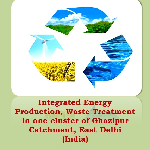 Abhik Tayal Jun 14, 2014 02:47 |
Hi Shailendra,
That's a very thorough project proposal plan. All the best for the competition results. Having presented here, you will give yourself a word of visibility for your actions to take shape.
Regards
Abhik Tayal
MIT Climate Co-Lab catalyst
|
 Agharese Lucia Ojelede Jun 14, 2014 08:53 |
Hello Shailesh-singh,
This is a very detailed proposal with a lot of research and feasibility conducted. There is no mention of training for the operators during technology transfer for this will also have some cost implications.
I wish you the best.
Arese
|
 Shailesh Singh Jun 16, 2014 04:03 | Proposal contributor
Thanks for your comments
|
 Osero Shadrack Tengeya Jun 17, 2014 09:27 |
Hi Shailesh,
Your proposal seems doable, i wish all the best in this contest.
Tengeya.
|
 Robert Dedomenico Jun 27, 2014 07:09 |
Shailesh-singh... Wow!
How could I not support this proposal? It is obvious that you care enough to have done thorough and exhaustive research on the potential, and the plan for realizing it. This and other similar plans also share some beneficial side effects in improved sanitation, and that translates into better quality of life.
I certainly hope to see this proposal advance.
Sincerely,
Robert DeDomenico
|
 Mark Capron Jun 28, 2014 01:03 |
Dear Shailesh-singh,
Go for it. I've noticed the necessary scale for using biogas (compression for transportation, cleaning for injection into utility pipes, electricity generation) has been dropping with improved technology.
|
 Loveleen Garg Jun 30, 2014 05:30 |
Dear Shailesh,
Proposal has come out very well. I have few following suggestions; if you find them appropriate, you can incorporate accordingly:
1) Stakeholder matrix is to be prepared so that responsibility of high priorty stakeholders can be understood.
2) Logistic arrangement for waste collection is to be touched upon .
3) Day wise analysis of waste generation is to be done so that optimum capacity of plant can be find out.
All the Best
Regards
Loveleen
|
 Mark Capron Jul 19, 2014 09:46 |
Dear Shailesh,
You may want to check out hydrothermal processes (http://www.gastechnology.org/tcbiomass2013/tcb2013/09-Elliott-tcbiomass2013-presentation-Thur.pdf) as a substitute for anaerobic digestion. The hydrothermal process converts wet biomass and plastics to oil and gas. You'll need a larger collection area for more economy of scale due to the higher capital cost of the equipment. However, it would allow you to give every home in a slum or refugee camp their own toilet with a supply of plastic bags. People would "go" in the bags and then give the bags to a push-cart operator. All very private and sanitary with no touching or spreading of human wastes. At sufficiently large scale (enough biomass) the income from the oil and gas production might completely offset the cost of all biomass and plastics collection and treatment.
|
 Shailesh Singh Jul 21, 2014 02:40 | Proposal contributor
Dear Oceaforesters Team,
Thank you very much for sharing such a critical information especially on hydro-thermal process of converting biomass waste into oil & gas.
Regards,
Shailesh S.
|
 Mark Capron Aug 9, 2014 07:17 |
Dear Shailesh,
You might want to consider using geosynthetics for less expensive digesters. Many U.S. dairy digesters are simple earth berms with a liner and lid. Some are so large they haven't needed to remove the settled solids (which keep decomposing) in a decade.
It should be possible to integrate your BIMA mixing technology into these large digesters. You might use a construction like the SolarBee mixing system: http://wastewater.medoraco.com/ where the top components are floating.
If you are set on steel or concrete walled tanks, consider a bolted steel tank with a geosynthetic liner and perhaps a gas storage dome like: http://www.claroglobal.com/en/p2-06.html.
When your digesters are relatively large and inexpensive, you could adjust your business model. For example, install several digesters close to the biomass sources (so close the farm or market input the biomass direct, without extra handling). Include sufficient biogas storage that the other equipment is mounted on trailers and shuffles from site to site. The biogas is easily conveyed in buried welded HDPE pipe. That is move the high-value, low volume items. Don't move the low-value, high-volume biomass.
|
 Climate Colab Aug 13, 2014 03:19 |
Thank you for submitting your proposal into the Climate CoLab.
We found this to be a very straight-forward and workable proposal.
For your revisions, please (1) make your business plan more clear and (2) address what makes this project novel and unique? Clarify or work in another component that would make it stand out from other similar projects.
|
 Hemant Wagh Sep 5, 2014 07:03 |
Could you consider requesting your future clients to store throughout the year the seeds of fruits they eat at home and spread those seeds after commencement of Mansoon on to vacant land in & around the city as an activity that would help improve green cover! Rather than wasting the fruit seeds by letting decay, this would help grow fruit-bearing trees as well.
|
 Climate Colab Sep 12, 2014 12:02 |
We have chosen not to advance it to the final round. I would have liked to have seen more about how this approach is novel in the field; India does a fairly good job with biogas at the moment, especially in Delhi.
Thanks for your submission and work to address these issues.
|
 Osero Shadrack Tengeya Sep 17, 2014 04:00 |
Hi Shailesh and your friends, kindly consider voting for my proposal shown on this link.
https://www.climatecolab.org/web/guest/plans/-/plans/contestId/1300206/planId/1002
Thanks.
|
